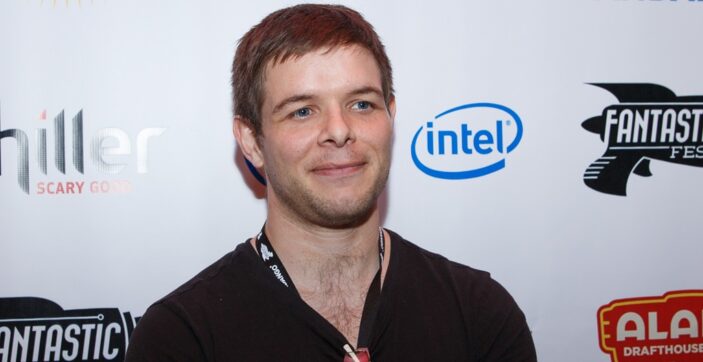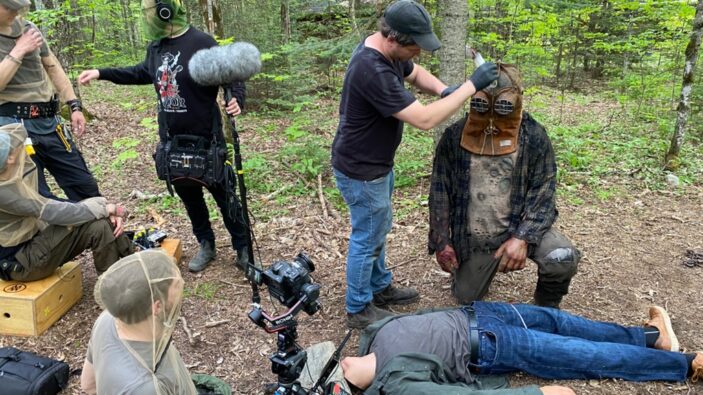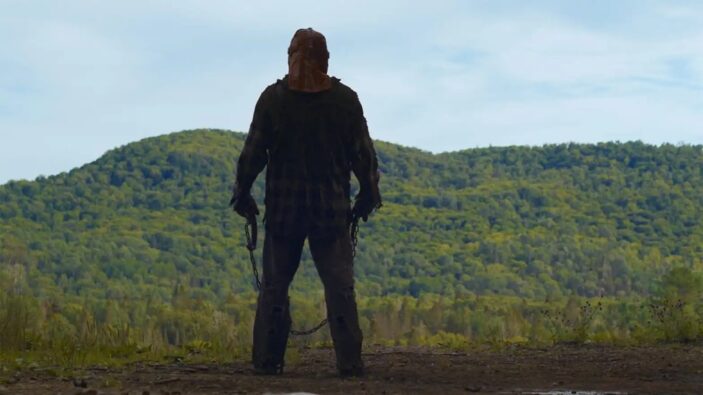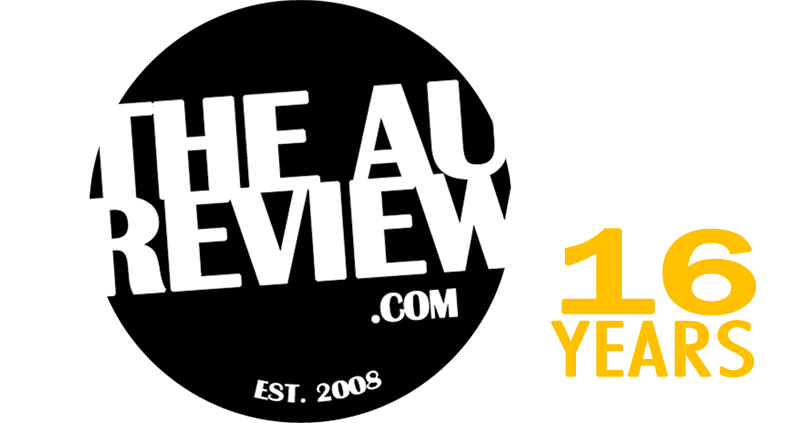
In A Violent Nature is being praised as a one-of-a-kind horror experience that must be enjoyed on the big screen. Following its premiere at the Sundance Film Festival in January as part of the festivals celebrated ‘Midnight’ program, this unique horror film released theatrically in the US on 1,426 screens and grossed US$3 million in its first week.
Written and directed by Chris Nash, the film follows a killer who goes on a murderous rampage in the Canadian wilderness; When a locket is removed from a collapsed fire tower in the woods that entombs the rotting corpse of Johnny, a vengeful spirit spurred on by a horrific 60-year-old crime, his body is resurrected and becomes hellbent on retrieving it.
Following the film’s critical acclaim and audience reception that saw several viewers reportedly fall ill at the gruesome sights on screen, In A Violent Nature is set to stalk Australian cinemas this week (you can read our review here). To coincide, our Peter Gray spoke with Chris about the director that inspired his decision to subvert genre expectation, the deliberate choices he made across the film’s score (or lack thereof) and narrative, and the death scene that had everyone talking.
WARNING: INTERVIEW CONTAINS SPOILERS.
It must be nice to come out of a festival like Sundance and see your film has found an audience. I heard so much about this slasher film of yours subverting the genre. Where did the idea come from that you knew you wanted to present this narrative from the perspective of the killer?
The idea came from being a really big fan of Gus Van Sant’s work in the 2000s and just growing up watching horror films. I was a huge fan of the genre and any kind of transgressive film in general, which is probably what led to my appreciation of Van Sant’s work. Watching things like Gerry and Elephant, and thinking “Oh, this is different.”
I wanted to see how it would look to take those cinematic elements and (his) cinematic aesthetic and put it into a genre that’s traditionally been regarded as more of, like, “termite art”, to use Manny Farber’s brilliant term. I just sat on that idea for years and years, until I spoke with friends on another production about slasher films and sharing with them about following a slasher the entire way like a Van Sant movie. Everybody was pretty receptive to that idea, and if I wrote it they’d help me make it. So, that’s what happened.
In terms of writing the script, obviously so much of a slasher film banks on the death scenes. When you’re writing this, are you thinking of the story and how the death scenes can fit into the narrative? Or do you come up with an idea and figure out how the story can surround that?
There’s always an initial seed, for sure, as far as what the approach is and what the actual tone is. For me, the initial seed was actually the scene where Johnny gets shot and he’s on the ground and the shooters are escaping through the woods. Just that notion of staying on him, staying with him, and watching him get up and grab an axe and throw it, and all we hear is it hitting something that falls to the ground. Then we stay on him as he slowly walks through the woods, and then we see that the axe is in somebody’s head, and he pulls it out. That moment was essentially my starting point for how we were going to approach the actual script.
We found where that would be placed in the script, but a lot of it was more or less free writing. Just wanting to have certain ideas and certain kills, and where they could go. It’s definitely a case of both ends meeting in the middle as far as the kind of kills and the story, and then working at it from both sides.

I feel like I can’t not mention “the yoga death scene.” It’s something we haven’t seen before, and it really brought me back to the horror films of the 1980s where all the effects are so practical too. How does something like this scene come to fruition?
I have a background in prosthetics and practical effects. I always try to punch a little above my weight, as far as doing effects that I haven’t seen before, but always in a different way. Essentially, it’s kind of the difference between the arena magic and close-up magic, where it’s seeing the same trick but from different points of view and perspectives. It becomes a whole different thing at that point.
For the yoga scene, how do I achieve having everything take place in one shot? How do we utilize those hooks in a way that’s very “hooky” that isn’t something that could be easily mimicked with a machete or something. It had to be intrinsic to the hooks themselves, and utilizing those hooks for what they are. A lot of it was also knowing it was going to take place on an expansive vista where we were going to see all all that was written into the script and playing that against something that’s incredibly gory.
I was thinking “How far do we take it? And can we take it even further than that?” In some films the ending point might have just been the hook in the head and that’s it, but how much destruction can we cause to one human body that leaves the audience feeling like there’s no way back from this?
One of the things that I really noticed about the film was the lack of music. I feel like music can so often be manipulative. It’s obviously very evocative and it can make audiences think something is about to happen. Was that a deliberate choice to keep the film as grounded as possible? It made it more eerie by keeping the sounds as organic noise.
Yeah, that was from the very start. That was written right into our pitch documents that we were not going to have a score and we were just going to use atmospheric sounds to be the entire score. I couldn’t agree more that I find music and score to be incredibly manipulative in film, for better or worse. There are some that find that symbiosis between a perfect image and the perfect score, and you can’t even set the two apart. There are some songs that I listen to that have been so perfectly used in film that as soon as I hear them I immediately visualise the movie. But that’s not something that can exist the other way around. You can’t see a movie and then throw a different score onto it, and I think that exemplifies just how the music can be used to manipulate an audience.
The pacing in this film is so deliberate. But with that comes such payoff with a lot of the sequences. Was that something you found in the edit as to how much walking you were going to focus on with Johnny and how much you need with him to make the death scenes worth it?
I think that our movie can definitely be regarded as slow, and I have no qualms with anybody feeling like, “Oh, this is a really slow movie.” I don’t think it’s slow. I think that there is that internal propulsion of just watching somebody walk. We could say audiences have shorter attention spans and they won’t be able to sit through and watch somebody just walk through the woods for an hour and a half, but I’ve watched countless Red Dead Redemption play-throughs (on YouTube) where I’m doing the exact same thing. I feel like as long as the audience has some level of comfort and confidence that the journey is going to lead somewhere, I think they’re really apt to take the ride.

Throughout the film we hear snippets of dialogue and eventual scenes that explain the lore of Johnny. When you’re writing the script are you detailing more than what we ultimately hear? Or was it always just sprinkled enough throughout for the audiences to piece together the rest?
There was a bit more in the script and a bit more shot, but because so much of the dialogue takes place off-screen, and there are very few moments other than the campfire scene where we’re right up with the characters, when it came to the edit it was definitely a game of “How much can we cut out and still hit those beats we need to hit?” Whether that’s an exposition dump, or what a character is holding in his hand, or those little hints of “This character is the asshole boyfriend”, or “The brooding loner”, and this is “The final girl”… all those things have to be touched on, but how much can we trim it back to just give the audience the bare information they need. In the end, for the majority of the film, it’s Johnny’s story, and Johnny doesn’t really care about any of that information.
Speaking of Johnny’s story, I will say that the final shot is weirdly beautiful and actually made me feel for Johnny. It’s not always the case with these films where we think that it’s all been worth it for the villain, so I love that this film really made those bold choices. I love horror and it feels like the genre is really taking risks, and I think so many people might expect this to play like a Friday the 13th, but it runs deeper than that.
Thank you. That’s an incredibly compliment. I really appreciate it. I think horror in general should be the genre used to take risks. I wish we were in a world where there were more exploitation films. More films where you hit these markers and do whatever crazy stuff you want to do in the meantime. That’s where the fun is, and that’s how the language of cinema changes.
In A Violent Nature is screening in select Australian theatres from August 1st, 2024.
